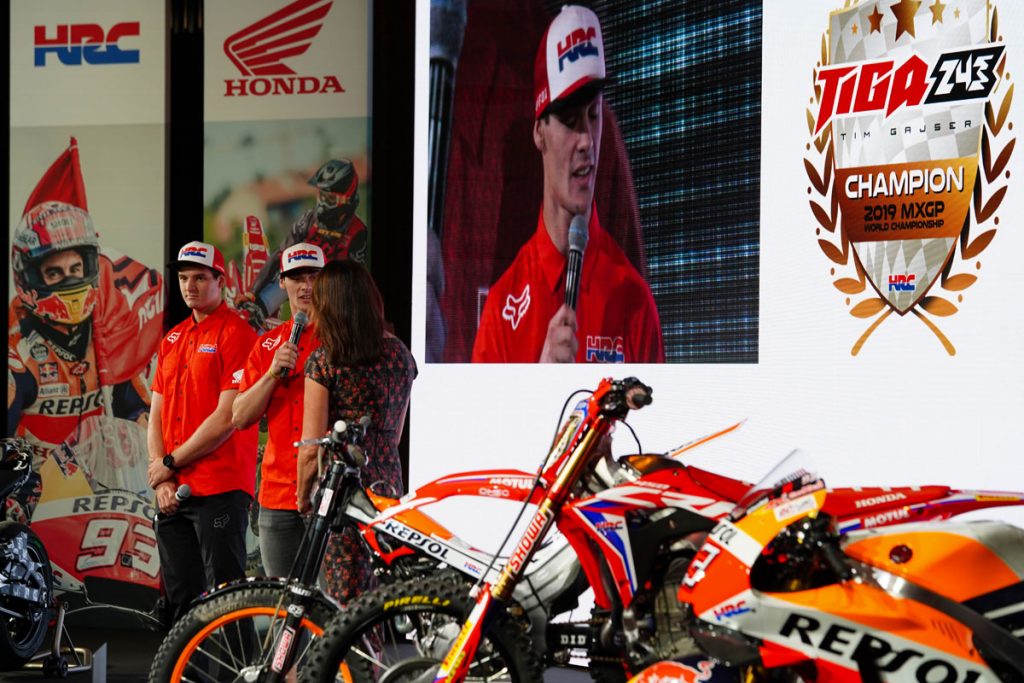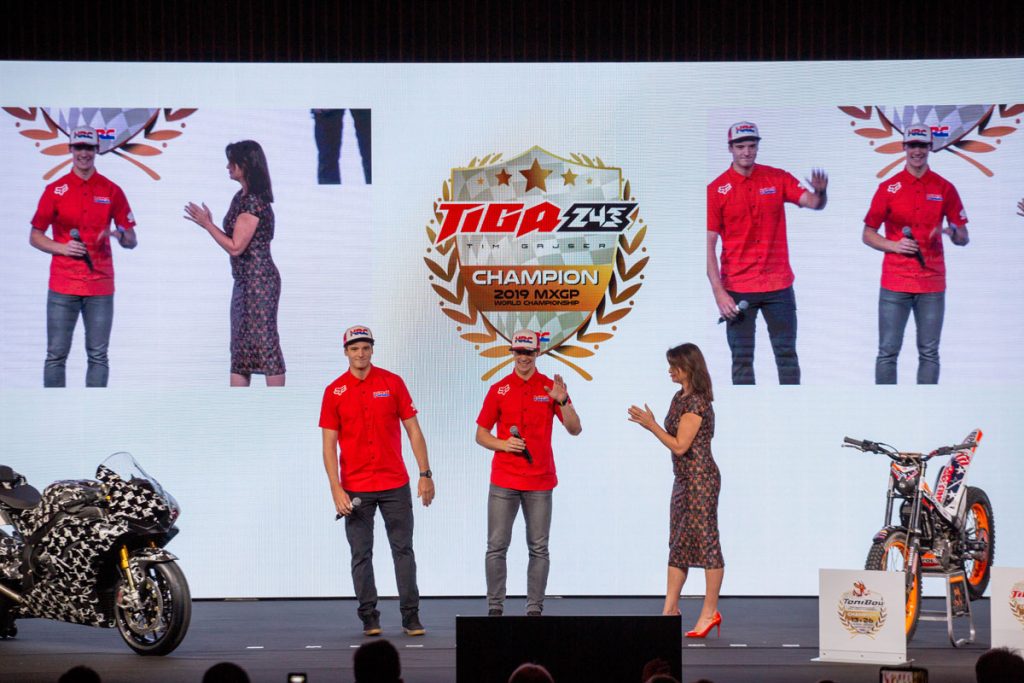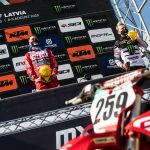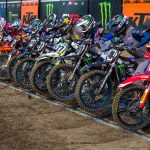In Valencia last week Honda dominated the headlines before, during and after the final round of MotoGP: Lorenzo, Marquez and seat-swapping. All the fuss about Moto2 world champion Alex Marquez taking the vacated Repsol Honda HRC berth next to his brother and in the Triple Crown winning set-up for 2020 struck a small chord for me with the HRC operation in MXGP where Australian Mitch Evans slots next to Tim Gajser. It seems that Honda are facing questions over the wisdom of their choices alongside their #1 athletes.
Although Alex Marquez’s predicament is tinged with nepotism and he had to break a contract with the Marc VDS team to take up the Honda opportunity, the 23 year old is a Moto3 and Moto2 world champion and is wholly deserving of his MotoGP shot; regardless of his surname. Evan’s position – as a one-season rookie of Grand Prix racing – is markedly different. In fact, a comment I saw on Twitter regarding the official announcement of his contract – something along the lines of ‘he must be paying for it’ – prompted some dismay.
It seems unbelievable that the world’s largest motorcycle manufacturer and arguably the most advanced race team in MXGP would have to contemplate a cut-priced option as a second rider. Certainly not one that has to fork out.
Part of the suspicion or reaction from MXGP followers may come for two reasons. Firstly in 2017 Honda made a double signing of Brian Bogers and Calvin Vlaanderen from the ashes of the HSF Logistics MX2 team and the principal sponsor went along with both Dutchmen. Bogers and Vlaanderen had shown potential in MX2 and their signatures were generally accepted as a change of strategy for Honda after their expensive investment in Gautier Paulin but these were not A-list acquisitions for the brand to accompany Gajser, who had rocked the MXGP class on his debut term in 2016. The fact that Bogers struggled with injury, then form and results and Vlaanderen was overlooked for the MXGP deal for 2020 adds to the ‘stop-gap’ feeling of the deal.
Secondly, deliberation and rejection of a rider with Max Anstie’s skillset (the Englishman seems all but certain to leave MXGP for 2020 after being left out in the cold) and the strong ensembles at KTM (Cairoli, Herlings, Prado), Kawasaki (Desalle, Febvre) and Yamaha (Paulin, Seewer, Tonus) means that the HRC wing is struggling for similar billing and strength as their rivals.

It’s important to remember that Evans is not an unknown or a random punt for Honda. He already caught the eye with a top ten finish in the slime of RedBud for the 2018 Motocross of Nations, riding a CRF450R for his country, and was then signed-up for the second year of Livia Lancelot’s 114 Motorsports team to replace Hunter Lawrence in MX2. A podium finish on his debut in Argentina last March was a revelation. But then the long, hard education of a full Grand Prix season and several crashes weakened the tall rider’s impact.
For MXGP Honda have promoted from within and they have identified youth. In this respect there are similarities to the strategy with Marquez in MotoGP, although the Catalan is from the same family and management group rather than Honda specifically (also, it could be argued that he was able to really excel in Moto2 only when Honda’s engines had been replaced by Triumph).
To gain some insight to the Evans appointment I called former HRC MX General Manager Roger Harvey, now an official advisor to the team.
“When Mitch opened his account in Argentina that was impressive and he rode well for the first half of the season but ran into problems when he tried to drop weight for the 250,” he says. “We could see the potential was there.”

Evans has only recently turned 21 and would have been eligible for two more years in MX2 but his imposing frame and capabilities on the 450 meant a more natural fit in MXGP. Whatever the Australian showed (and the approach he took to his racing) in 2019 clearly resonated with both current General Manager Marcus Pereira de Freitas and Harvey and he was signed to the second CRF early in the summer. “We knew he would be better on a 450 and it is also an age thing and that’s why he became such a strong option,” Harvey adds. “Taking another proven rider for 2020 was an option…but we wanted something similar to Tim in the past where we could school, learn and teach someone with a lot of capability.”
“He will be given time,” Harvey continues. “MXGP is so stacked now. We know we have a youngster. If he gets up to running 10th-12th then that’s something we’d be looking for [in 2020].”
Roger admits that Evans’ newcomer status in the world championship carries favourable financial implications compared to, say, an established GP winner (“we all work to budgets…) and in the general picture of Gajser allegedly being one of the best paid riders in the series with his long-term Honda agreement. But #43’s luck or positive timing is to be in the right place at the right moment with the right age and the right prospect.

HRC is one of the largest set-ups in MXGP but two of their factory foes have three-rider rosters, mainly to cope with the demands of twenty rounds, forty motos and sixty starts in 2020. It begs the question why can’t Honda do the same and give Evans that ‘third rider/junior/development’ role? They could have even kept Vlaanderen; an athlete who has aged out of MX2 and admirably represented their now-mysteriously up-in-the-air 250 programme. “There was a consideration to run three riders but ultimately the decision was made to focus totally on two projects for MXGP and squarely on product development for the future,” concludes Harvey. “We wanted to bring Calvin up to MXGP a year earlier but he wanted one more chance to try and crack MX2. He was considered.”
Alex Marquez could have only a few months to hit the ground running before the vast MotoGP contract movements for 2021 begin (almost the whole paddock is available) and Evans could be in the same predicament, even though contract durations have not aligned as neatly in MXGP as MotoGP. If anything, the situation for Vlaanderen, who is now on a Yamaha, proves that pressure to deliver and make the right choices is crucial when it comes to career openings with the best equipment and structures in the sport.
By Adam Wheeler @ontrackoffroad
Photos by Honda/Ray Archer








